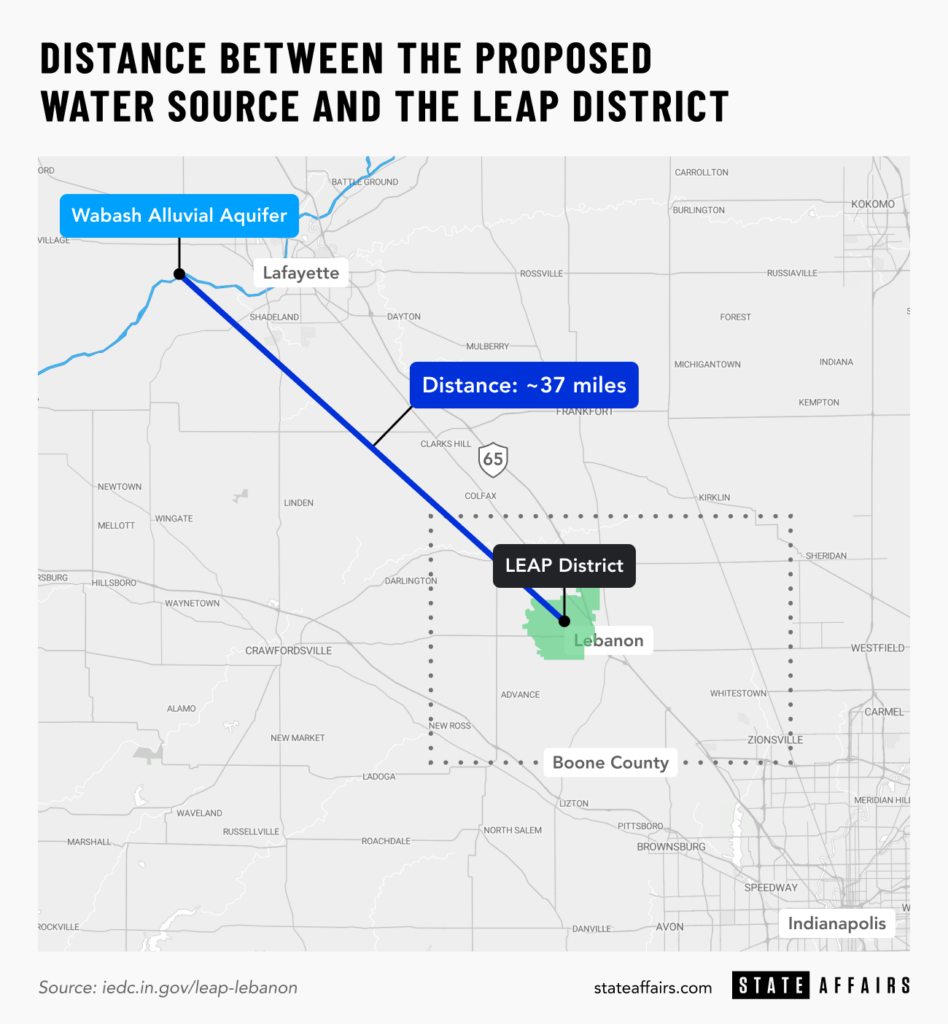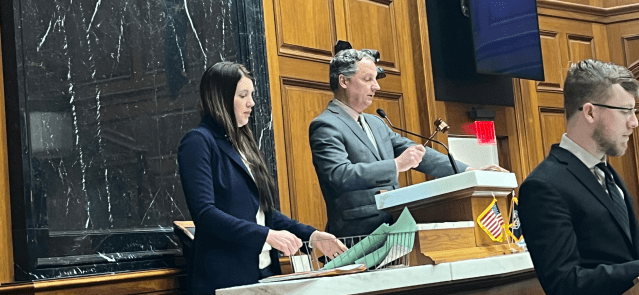Stay ahead of the curve as a political insider with deep policy analysis, daily briefings and policy-shaping tools.
Request a DemoWho will pay for water pipelines for the LEAP District? It could be ratepayers, consumer advocacy group says

Wabash River in Lafayette, Ind. (Credit: qsthomson)
Update 12/14: A spokesperson for Citizens Water said the company will not be supplying water for the LEAP District, which means those customers would not have to pay for a pipeline supplying water to the LEAP District. Other water users could still be on the hook.
"We were very clear in our filings that we would not participate in an agreement that held our existing customers responsible for any costs associated with the project," Laura O'Brien, a spokesperson for Citizens Water, said in an emailed statement."
The gist
A utility-focused consumer advocacy group is calling for the abolishment or reformation of the state’s quasi-governmental economic development agency following concerns about how it has handled the LEAP Innovation and Research District’s water needs.
In a report, Citizens Action Coalition warned that the added cost to build pipelines moving water to the LEAP District, a future 9,000-acre tech hub in Lebanon, could lead to rate increases for everyday water users in central Indiana.
That means your water bills in central Indiana could go up, depending on which company the Indiana Economic Development Corp. ultimately works with to bring water to Lebanon.
Aside from that concern, Citizens Action Coalition questioned why the IEDC committed taxpayer dollars to the LEAP District project prior to finalizing a sustainable plan for water and completing testing. The process was completed in “reverse order,” the report says.
“The shell-game with water to enable the LEAP district is fomenting public dissent and a water war, contrary to sound water policy,” the Citizen Action Coalition wrote in its LEAP report.
The IEDC did not immediately respond to a request for comment about the report.
What’s happening?
Because of the LEAP District, the IEDC has the land and flexibility to quickly lure high-tech industries to the state. Already Eli Lilly has plans to build two manufacturing facilities in the district.
But the high tech companies the IEDC is targeting, such as semiconductor chip manufacturers, would require millions of gallons of water daily.
There just isn’t enough in Boone County to sustain those industries without bringing in water from elsewhere.
Secretary of Commerce David Rosenberg previously told State Affairs that water scarcity is an issue in central Indiana that would have to be addressed regardless of the LEAP District.
“Our premise was, can we use economic development to unlock the resources to not only provide additional water for potential companies coming into these areas,” Rosenberg said, “but really solve a regional, generational water issue that everyone has identified and has known about for decades and decades.”
The IEDC hopes to funnel water from the aquifer that sits adjacent to the Wabash River in Tippecanoe County roughly 40 miles away, if ongoing studies show there is enough water there. Residents and elected officials there have sounded the alarm about the plan, fearing it would impact their ability to expand and have little benefit to their own communities.

Meanwhile, the IEDC says it will only take water if studies show there is enough to sustainably withdraw.
The IEDC also has plans to build another pipeline from Indianapolis to the LEAP District to supply 10 million gallons of water per day. The initial plan was for Citizens Water, the Indianapolis water utility, to handle that portion of the project, but the company later backed out.
Rosenberg said the state has a plan to still supply that 10 million gallons but could not yet say which company the state would be using.
Who would pay for the water?
Citizens Water initially predicted the pipeline from Indianapolis to Lebanon would cost $200 million, paid for by a loan through the state and later paid off by the IEDC. But that plan was formulated before Citizens Water pulled the plug on its proposal.
That means there’s no guarantee some of the costs won’t fall to water users in the form of higher rates. If Indiana American Water is chosen, for example, that could mean added costs for ratepayers in Hamilton County.
Rosenberg declined to say which company would be supplying that 10 million gallons of water per day, but said it was “no longer necessary for Citizens to move forward with a rate case.” Citizens Water told State Affairs that the company would not be supplying water to the LEAP District.
Likewise, it’s unclear who will pay for the cost of the other, more pricey pipeline from Tippecanoe County to the LEAP District. Lebanon Mayor Matt Gentry said he’s been told the pipeline would cost $2 billion, but the IEDC says there is no estimated cost.
“There has been no discussion of: How the purported $2 billion for two pipelines from the Wabash basin to Lebanon will be paid for or who is going to manage it – although CAC believes that it will be water ratepayers, most likely the ratepayers of Indiana American Water that owns the West Lafayette water utility and utilities in Hamilton County,” the report says.
What Citizens Action Coalition recommends
Citizens Action Coalition noted other concerns in its report as well, echoed by others in Tippecanoe County. Will water supplies elsewhere be stressed? Why isn’t the state more focused on water conservation efforts?
Citizens Action Coalition made nine recommendations including:
- The state should develop a sustainable water policy that includes a focus on conservation (such as fixing current infrastructure to stop leaks).
- Eli Lilly should pay for a portion of its water infrastructure. Likewise, any additional funding for water infrastructure for economic development should come from taxpayers, not water users. If taxpayers directly pay for the infrastructure, it would minimize the money utility companies get to keep for themselves, Citizens Action Coalition said.
- Local communities should have control over ground water. At the very least, there should be guardrails surrounding large water withdrawals.
- Lawmakers should replace the IEDC with “a transparent department of commerce or significantly reform” it in order to increase transparency and public input.
What’s next?
At the request of the IEDC, INTERA Inc., a geoscience and engineering consulting firm, has started testing how much water can sustainably be withdrawn from the aquifer adjacent to the Wabash River.
Last month, Gov. Eric Holcomb directed the Indiana Finance Authority to take over oversight of the INTERA water supply study.
The finance authority will also start a comprehensive regional water study for north-central Indiana, expected to be completed in fall 2024.
The issue of who should control the state’s water will likely be debated during the 2024 legislative session which starts in January.
Contact Kaitlin Lange on X @kaitlin_lange or email her at [email protected].
Facebook @stateaffairsin
Instagram @stateaffairsin
LinkedIn @stateaffairs
Read this story for free.
Create AccountRead this story for free
By submitting your information, you agree to the Terms of Service and acknowledge our Privacy Policy.
Here’s how to vote in Indiana’s primary election
Thousands of Hoosier voters will head to the polls Tuesday, May 7, for Indiana’s primary election. This year’s ballot includes a competitive contest for governor, as well as dozens of state and federal legislative races and a few school referenda. The primary will decide which candidates will represent their respective parties in the Nov. 5 …
$15B in 72 hours: ‘Our economy is on fire,’ says Commerce chief
A banner week for investment within Indiana has capped off the state’s biggest financial quarter in recent history, as three major companies agreed to deals estimated to bring in billions of dollars.
The state has long advertised itself as business-friendly, and its chief executive appeared thrilled by the week’s news.
“This is about $15 billion in about 72 hours,” Gov. Eric Holcomb told reporters on Friday. “This used to take four years to achieve.”
One announced project, an $11 billion Amazon Web Services data center in north-central Indiana, is the biggest single investment in the state’s history.
Google also broke ground on a $2 billion data center near Fort Wayne, while Toyota announced a $1.4 billion investment in its Princeton plant.
“Our economy is on fire,” Secretary of Commerce David Rosenberg said.
His agency, the Indiana Economic Development Corp., negotiated the deals. The state is offering millions of dollars in tax incentives in order to create some 1,500 new jobs.
“These industries bring generational change for families, putting more money in their pockets and allowing them the opportunity to have a better quality of life on their own,” Rosenberg said.
The projects
Amazon’s new data center will be built near New Carlisle. It’s expected to bring in at least 1,000 new jobs in the artificial intelligence and cloud storage sectors. No timetable for completion of the project was given.
According to Amazon, the company has invested $21.5 billion in Indiana since 2010, creating 26,000 full- and part-time jobs.

Google’s new data center will hire up to 200 new workers, the tech giant said, “in the coming years.”
Toyota will build a new assembly line that will assemble battery-operated SUVs by the end of 2025. It expects to add up to 340 new jobs to the plant, which Toyota said now employs more than 7,500.
The company has spent $8 billion on the Princeton plant since breaking ground in 1996, Toyota said.
The new projects’ figures represent early estimates and could change as they move forward.
Incentives aren’t the only factor
Rosenberg praised the Indiana General Assembly for passing legislation that allows the state to offer sales tax exemptions as a lure for new businesses. Both Amazon and Google will receive such boosts, and the Amazon project could receive up to $100 million in additional credits based on various incentives.
But Rosenberg stressed tax breaks are only part of the equation as the state looks to compete internationally.
“We don’t have to have the highest offer because we bring the university partners, the state and local governments, utilities — everyone around the table to make sure that company has what they need,” he said.
The Google project, for example, includes partnerships with Ivy Tech Community College on a new job training program and Indiana Michigan Power to bring clean energy resources to the local grid.
Recruiting new industries
Rosenberg said tech recruitment has been a particular focus for the IEDC, as Indiana is looking to provide an “ecosystem” for these companies to thrive off one another. The state’s semiconductor facilities will provide the materials needed for these new data centers, he noted.
Recruiting new business takes anywhere between six months to several years. Zoning, road construction, utilities and more need to be worked out ahead of time.
The IEDC has been on a hot streak, Rosenberg said. During the agency’s first 11 years, it secured just under $50 billion in new projects. It has now pulled in more than $71 billion since the beginning of 2022.
In the first four months of 2024, $20.68 billion has been pledged to projects in Indiana — the most for a quarter since IEDC’s founding in 2005.
‘Strong partners for the Indiana economy’
“The key is that these investments represent long-lasting and continued commitment to being strong partners for the Indiana economy,” said Andrew Butters, an associate professor of business economics and public policy at Indiana University’s Kelley School of Business.
Large companies came out of the pandemic looking to reorient their supply chains, Butters said, and some states have reaped the benefits of projects that might have previously moved overseas.
Indiana has been able to compete by selling its location, workforce, labor force participation in addition to offering incentives, Butters said.
“I would not be shocked to see more of these as the state attempts to transition toward more high-tech and high-skill industries,” Butters said.
Contact Rory Appleton on X at @roryehappleton or email him at [email protected].
6 races to watch in the Indiana primary election
The first openly competitive contest for the Republican gubernatorial nomination in a generation will end with Tuesday’s primary election, as will crowded races for several open congressional seats.
The primary won’t officially decide any political race — only the Nov. 5 general election can do that. But Republicans hold major advantages in statewide and many district-level contests, and who secures which nominations will go a long way toward deciding who may lead the state in the years to come.
>> Related: How does voting by political party work in Indiana?
Here are six key primary contests to watch on election night.
Governor
The race to be Indiana’s next chief executive has been perhaps the most noteworthy of the election cycle, with six Republicans bringing a variety of experience and outsider credentials to the competition.
Sen. Mike Braun has led in the polls from day one, including running up a 34 percentage-point lead in an April State Affairs/Howey Politics Indiana survey.
The other five candidates are: Lt. Gov. Suzanne Crouch, former Attorney General Curtis Hill, Indianapolis mom Jamie Reitenour and two former state secretaries of commerce in Brad Chambers and Eric Doden.
The winner of Tuesday’s Republican primary will face Democrat and former state Superintendent of Public Instruction Jennifer McCormick, who will advance for her party unopposed.
Republican candidates spent tens of millions of dollars in an attempt to stand out in their crowded pack. The primary race also featured four televised debates, including a chaotic final display on April 24.
U.S. Senate
Two Democrats are vying for the chance to replace Braun in the U.S. Senate: Former state Rep. Marc Carmichael and Valerie McCray, a clinical psychologist.
Carmichael has outspent McCray in the race by a margin of nearly $63,000 to $15,000.
Both are attempting to become the state’s first Democratic senator since Joe Donnelly’s election in 2012.
Rep. Jim Banks is running unopposed in the Republican primary.
3rd Congressional District
Banks’ entry into the Senate race leaves his seat in Congress open, and a bevy of Republicans are seeking to replace him: Grant Bucher, Wendy Davis, Mike Felker, Jon Kenworthy, Tim Smith, Marlin A. Stutzman, Eric Whalen and Andy Zay.
State Affairs has identified Stutzman, a former congressman; Smith, a self-funding former Fort Wayne mayoral candidate; and Davis, a former Allen County judge, as candidates to watch in the crowded race.
Kiley Adolph and Phil Goss are running against one another in the Democratic primary.
5th Congressional District
After initially deciding against another run, Republican Rep. Victoria Spartz reversed course to seek re-election in 2024.
Eight other Republicans are running against Spartz: Raju Chinthala, Max Engling, Chuck Goodrich, Mark Hurt, Patrick Malayter, Matthew Peiffer, L.D. Powell and Larry L. Savage Jr.
Goodrich, a member of the Indiana House of Representatives, has spent more than $2 million on TV ads as he seeks to unseat Spartz, according to AdImpact.
Two Democrats, Ryan Pfenninger and Deborah A. Pickett, are on the ballot.
6th Congressional District
Seven Republicans are attempting to replace retiring Rep. Greg Pence: Jamison E. Carrier, Darin Childress, Bill Frazier, John Jacob, state Sen. Jeff Raatz, Jefferson Shreve and state Rep. Mike Speedy.
Shreve, who ran unsuccessfully for Indianapolis mayor in 2023, has spent nearly $4 million — predominantly through TV advertising — in his bid.
Cynthia Wirth, whom Pence defeated by 35 percentage points in 2022, is running unopposed in the Democratic primary.
8th Congressional District
Republican Rep. Larry Bucshon is also retiring, and a dozen candidates in both parties are seeking to fill his seat.
On the Republican side, former Rep. John Hostettler, state Sen. Mark Messmer, former President Donald Trump White House staff member Dominick Kavanaugh and frequent Bucshon primary challenger Richard Moss are each making a push.
Fellow Republicans Jim Case, Jeremy Heath, Luke Misner and Kristi Risk are also running but trail the above pack in campaign spending.
Four Democrats are also seeking a nomination: Erik Hurt, Peter FH Priest II, Edward Upton Sein and Michael Talarzyk.
Contact Rory Appleton on X at @roryehappleton or email him at [email protected].
State Republicans keep spending to protect House incumbents in primary
House Speaker Todd Huston expressed confidence Tuesday that Republican House members will prevail over challengers in next week’s primary. Nineteen of the 63 House Republicans seeking reelection this year are facing primary races. Those challenges have been lower-key than two years ago when about two dozen candidates seized on COVID-19 discontent and other issues in …




